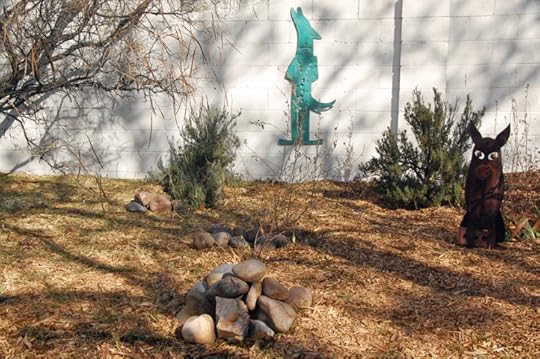Rocks On!
 Cobbles, Coyote, and Puerco Real
Cobbles, Coyote, and Puerco RealI mentioned a few weeks ago that Jim and I had scored a very large amount of chipped and shredded wood mulch. We moved somewhere between ninety and a hundred garden carts of it to our back yard, and spread as much as we could without interfering with plants that hadn’t yet died back for the winter.
As our temperatures drop (we’ve hit the low twenties) and the summer plants die back, we’re slowly finishing spreading the mulch. As we finish up an area, we’re also placing and replacing the river cobbles we use as garden borders.
You might wonder why, given how hot our climate can be, especially in summer (last summer’s high was a relative cool 107 F), do we landscape with rocks?
It may seem odd, but our river cobbles help our local ecology in several ways. One of the most obvious is helping direct moisture, both when we get rain, and when we water. But rocks can also serve to help ameliorate our temperature shifts, which routinely shift at least 30 degrees between night and day, and not uncommonly shift 40 degrees or even 50.
Years ago, Jim and I planted a Tuscan Blue rosemary. Initially, it did well, but then it began to fail.
“Give it a rock,” said our friend Erich. “It will help the rosemary deal with temperatures shifts.” We were dubious, but we did. The Tuscan Blue rosemary is still with us, still thriving.
The use of rocks as a means of retaining moisture and managing temperature shifts goes way back. Jim has excavated sites going back 700 or more years, where the indigenous population created “waffle gardens” where river cobbles were often used to border gardens, sometimes covering much of the surface area. There are also examples of gravel mulched gardens as well.
So, as I crawl around my yard, moving river cobbles here and there, not only am I creating visual accents, I’m helping the wild plants to thrive, and participating in a longstanding gardening tradition.
Pretty cool, right?



